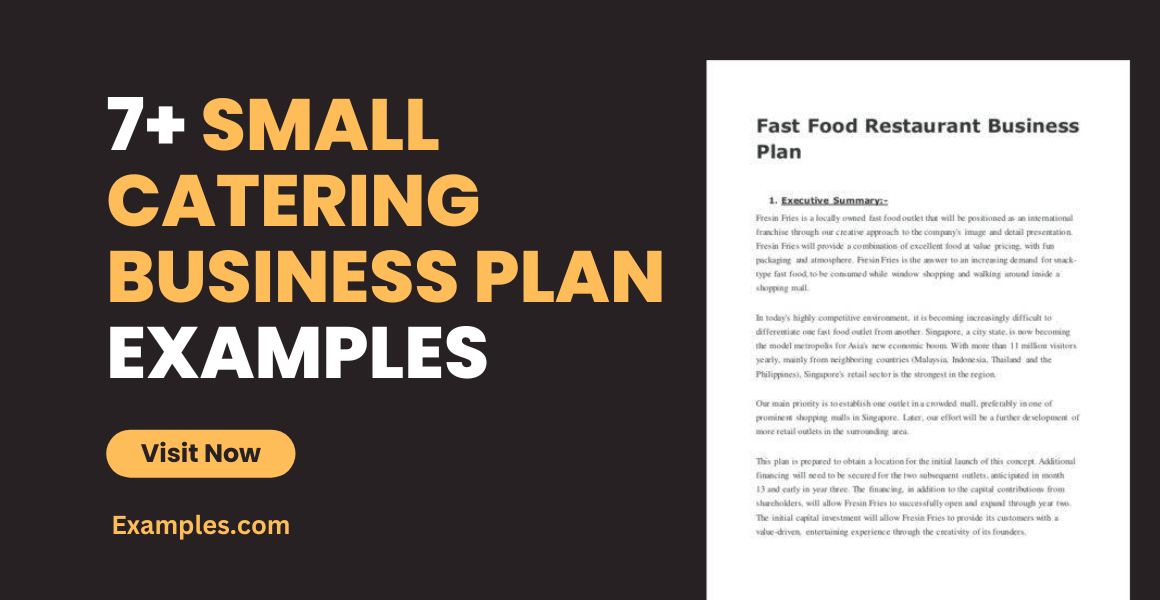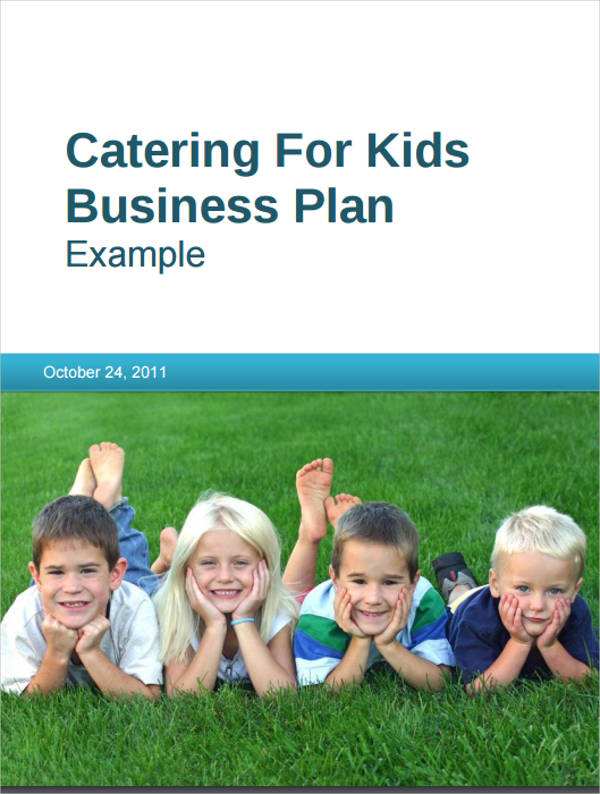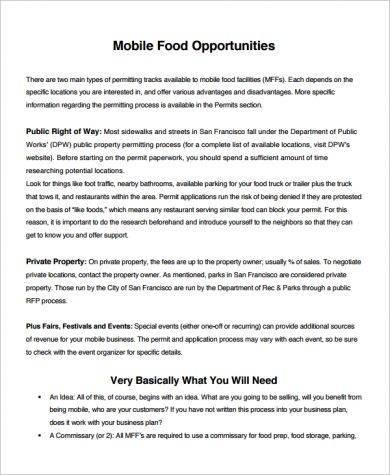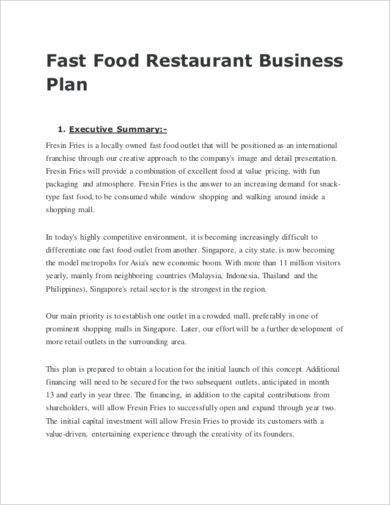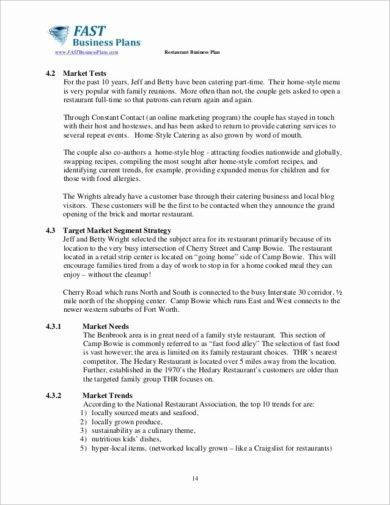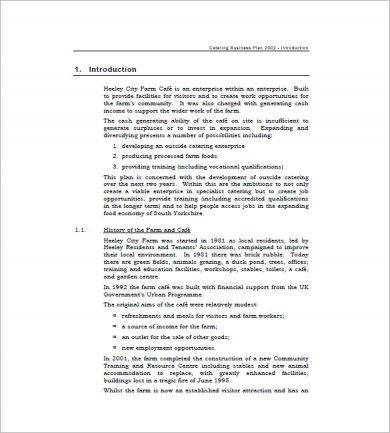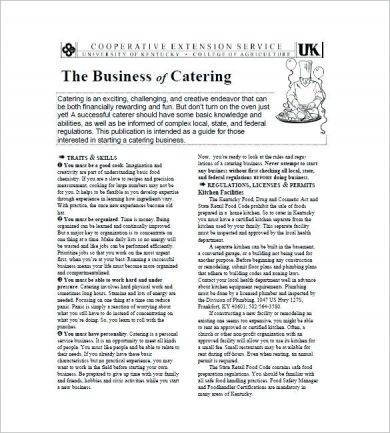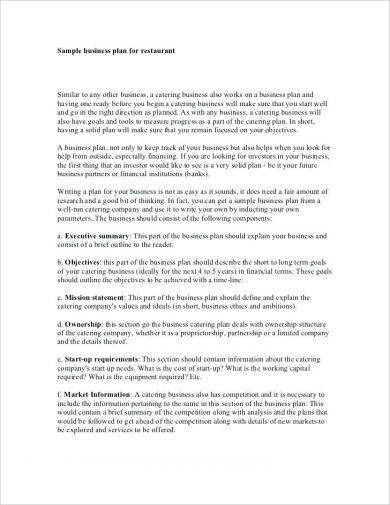7+ Small Catering Business Plan Examples to Download
Establishing your own small catering business is not easy, but it is certainly not impossible. There are numerous factors involved when setting up your own catering business, but if you are determined enough, then there is no reason for you to fail. But before you even start to purchase raw materials and ingredients for your catering business, you first need to create a business plan.
To help you create a business plan, here are some small catering business plan examples you can use as reference. They are also free to download!
Catering Business Plan Design Example
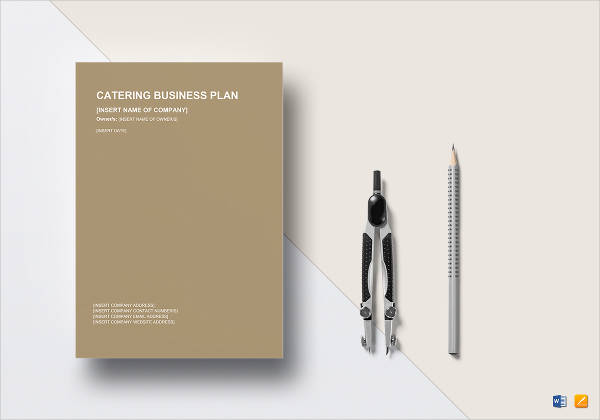
Small Catering For Kids Business Plan Example
Mobile Food Small Catering Business Plan Example
Tips in Creating a Small Catering Business Plan
Listed below are some important tips in creating a small catering business plan. Make sure to follow these tips so that you can create an effective business plan for your catering business.
1. Start off with a business profile
Similar to other business plan templates, it always begins with a short profile of the company. In this case, begin your catering business plan with a short background of your catering business. List down the name of your business, the dishes you cook, your target market, organizational structure, physical address, and online media profile (website and social media).
The business profile is very helpful when you will be introducing the company to the readers of your business plan, especially to your clients and external stakeholders. It gives the readers a background of your company which eliminates the need on your end to explain in detail the company profile to the readers, unless they request that you sit down with them to discuss the background and operations of the company.
2. Focus on marketing
One subsection of a business plan that carries the most weight in a business plan is the marketing plan. Although there are some companies that create a marketing plan as a separate entity, a marketing plan incorporated in a business plan is the most common form of marketing plan since a business plan analyzes different business aspects and functions such as sales, marketing, accounting, human resource, etc.
Take note that marketing does not only focus on advertising and promotion, but it also discusses how products are made (raw materials used, processes included in creating the product, etc.) and how products impact and provide benefits to customers.
Marketing also delves on strategic planning and what strategic methods to use to improve sales and eventually profit. Some of the popular strategic planning methods that companies use include SWOT analysis, PESTLE analysis, balanced scorecard, growth-share matrix, and Porter’s five forces.
3. Create financial forecasts
Financial forecasts is also important for any business plan, especially since you want to create calculated predictions on how your product will perform in the market. Financial forecasts also serve as a guide or blueprint on the financial goals you want to achieve for your company. There are numerous financial tools you can use, but there are other tools that are complicated and requires an accountant to compute and analyze.
Do not hesitate to hire a licensed third-party accountant to create your financial forecasts, especially if you have struggles creating the forecast for yourself and your company.
Executive Summary Small Catering Business Plan Example
Easy Business Plan Template for Small Catering Example
Intro for Catering Small Business Plan Example
Easy-to-Make Dishes You Can Serve for Your Catering Business
Listed below are some easy-to-make dishes you can serve for your guests in your catering business. You don’t have to make it difficult for yourself and your kitchen staff when making dishes. Remember that taste is still king and guests will enjoy more if they are familiar with the ingredients or flavors. You may also see business plan guidelines examples.
1. Caesar Salad
To start off with your appetizer, go for a crowd favorite. Remember when serving Caesar salad in a party or gathering, separate all the ingredients in different bowls or plates and avoid mixing the ingredients together and serving them directly to guests. A number of guests may not prefer some of the ingredients, so it is highly suggested that you separate all the ingredients beforehand and let the guests mix the ingredients by themselves. You may also like business operational plan examples.
Take note of these essential Caesar salad ingredients before serving them to your guests: lettuce, Parmesan cheese, croutons, cherry tomatoes, bacon bits, and Caesar salad dressing (made of garlic, pepper, mustard, vinegar, mayonnaise, olive oil, and lemon juice).
Caesar salad alternatives: Cobb salad, Israeli salad, Mediterranean chicken salad
2. Tacos
Tacos is another crowd favorite which is easy to make. You have the option to separate the ingredients similar to the Caesar salad or assemble the ingredients ahead of time so that the guests can easily pick them out during the party or gathering. There are only four main ingredients to the classic Mexican Taco: the taco shell, meat filling, grated cheese, and salsa. You may also check out hotel business plan examples.
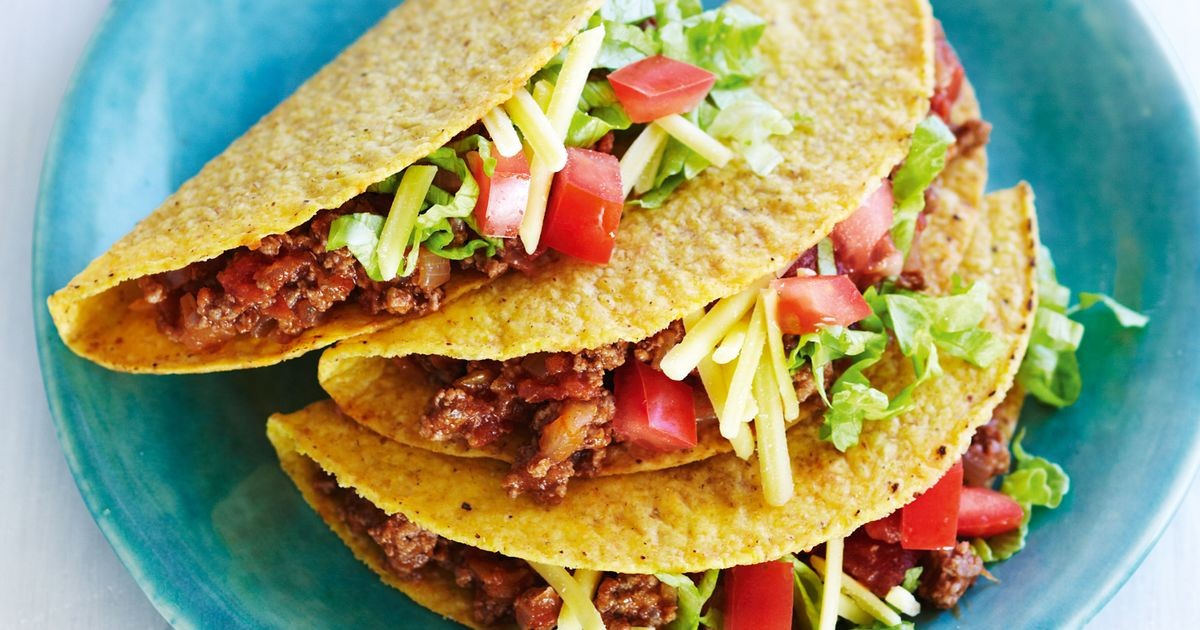
To create the meat filling, you only need ground pork or beef, minced onions and garlic, chili powder, cayenne pepper, and oregano. Mix all the ingredients together until the meat is cooked. For the taco salsa meanwhile, mix together tomatoes, onions, jalapeno chili, lime, salt and pepper. Tacos are certainly one of the easiest dishes to make, but is also one of the most delicious. You might be interested in market analysis business plan examples.
Taco alternatives: burritos, quesadillas, nachos
3. Gyoza and Sushi
Why not go international with your dishes? Give your guests a taste of Japan with a gyoza and sushi combination. You don’t have to serve the two dishes in the menu, but the more the choices your guests have, the better. Gyoza and sushi are also very easy to make and don’t require expensive ingredients just to have a great tasting flavor. You may also see how to do market analysis of a business plan.
Gyoza is a form of dumpling where ground pork mixed with cabbage and other seasoning is wrapped inside a wrapper, which is then fried (or steamed). Sushi meanwhile has different variations, but the most popular ones are the rice balls wrapped in nori and the rice balls attached to a slice of raw fish. Either way, both variations are delicious and your guests will certainly be munching on them until they look like Japanese themselves! You may also like business plan outline with examples.
Gyoza and sushi alternatives: sashimi, tempura, takoyaki, yakisoba
4. Grilled Food (Pork, Beef, or Seafood)
Grilled food is probably the safest choice of food to serve in a party. But safe doesn’t have to mean the food is bland or overly simple. Grilling prime grade beef or fresh seafood may not require five-star chef skills, but grilled food is definitely the most beloved dish of millions of people around the world. You may also check out implementation plan examples.

Even if you’re a vegetarian, there are certainly times that you just want to eat a whole slab of steak. The secret is definitely in the aroma.
Once you get the smell of meat starting to cook in char coaled flames and being subsequently rubbed by home-made barbecue sauce (which by the way you can serve as a side as long as the sauce was not used to flavor the raw meat in the grill), there is really just no stopping from the gastronomic experience that’s about to come. You might be interested in evaluation plan examples.
Here are some of the best meat cuts and seafood to grill: chicken or turkey, flank steak, top loin, tenderloin (pork or beef), T-bone steak, sirloin, ground beef, veal, pork chop, lobster, shrimp, scallops, oysters
Grilled food alternatives: kebab, baked chicken, pan seared beef, fried chicken, burger steak, fish fillet
5. Mini Cheesecake Cupcakes
What’s better than a cheesecake? A mini cheesecake cupcake! These are basically bite sized versions of the famous dessert which originated from Greece.
Cheesecakes are considered to be elegant desserts, but you don’t have to break the bank since ingredients for this sinful indulgence won’t cost you much and all of your guests can enjoy a bite due to their small sizes. Additionally, your guests will be looking for something sweet after consuming large chunks of meat, hence the mini cheesecake cupcake is your best option. You may also see advertising and marketing business plan examples.
Mini cheesecake cupcake alternatives: red velvet cupcakes, vanilla and chocolate cupcakes, fresh fruit slices
6. Ice Cream
The last entry in this list is everyone’s favorite dessert—ice cream. Take note that making ice cream is very easy, but you need to invest a significant amount for a quality ice cream maker. Mixing ice cream ingredients together and placing them in a freezer afterward will not result into ice cream that everyone loves to eat on a hot summer day (or during midnight when you want to sneak out for some cold and sweet snacks).

You can start off by serving the most basic flavors such as vanilla, strawberry, and chocolate. You can also serve different flavors together and prepare additional syrup, sprinkles, and peanuts in which guests can make some decadent ice cream sundaes. You may also see food catering business plan examples.
Ice cream alternatives: yogurt, parfait, cookies
Small Catering Business Write-up Intro Example
Small Catering Restaurant Proposal Plan Example
We hope you found this article to be informative and helpful when you will be creating your own small catering business plan.
A catering business is similar to a restaurant, but instead of customers coming to you, you will be going to your customers. Catering businesses also require you to cook by bulk, which contrasts to a restaurant where two servings are divided on a daily basis. You may also see event operational plan examples.
As previously mentioned, setting up a catering business can be tricky at times since there are numerous factors involved. But as long as you do enough research and follow the tips (and use the examples) we stated above, then your catering business will truly be a success. You may also like company plan examples.
Also, if you are determined enough then there is no reason for you to fail. But before you even start to purchase raw materials and ingredients for your catering business, you first need to create a business plan.


